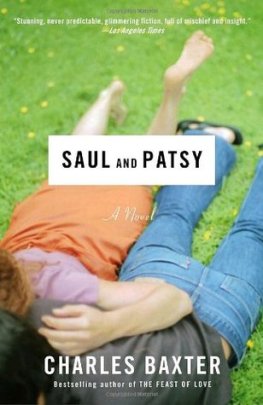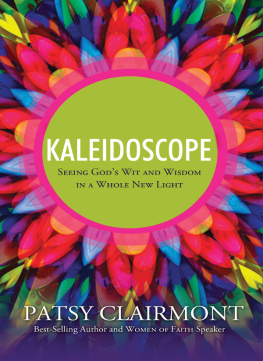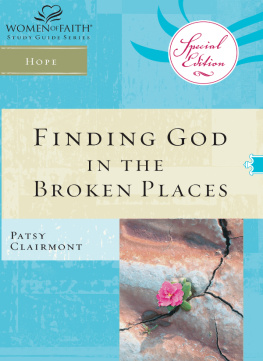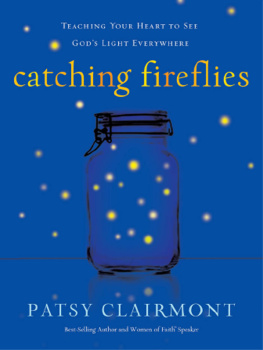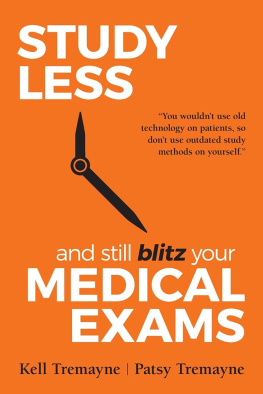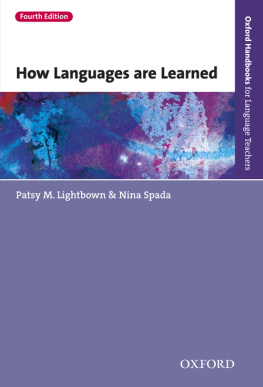Patsy M Lightbown - How Languages Are Learned 5th Edition
Here you can read online Patsy M Lightbown - How Languages Are Learned 5th Edition full text of the book (entire story) in english for free. Download pdf and epub, get meaning, cover and reviews about this ebook. year: 2021, publisher: OxfordUP, genre: Children. Description of the work, (preface) as well as reviews are available. Best literature library LitArk.com created for fans of good reading and offers a wide selection of genres:
Romance novel
Science fiction
Adventure
Detective
Science
History
Home and family
Prose
Art
Politics
Computer
Non-fiction
Religion
Business
Children
Humor
Choose a favorite category and find really read worthwhile books. Enjoy immersion in the world of imagination, feel the emotions of the characters or learn something new for yourself, make an fascinating discovery.

- Book:How Languages Are Learned 5th Edition
- Author:
- Publisher:OxfordUP
- Genre:
- Year:2021
- Rating:4 / 5
- Favourites:Add to favourites
- Your mark:
- 80
- 1
- 2
- 3
- 4
- 5
How Languages Are Learned 5th Edition: summary, description and annotation
We offer to read an annotation, description, summary or preface (depends on what the author of the book "How Languages Are Learned 5th Edition" wrote himself). If you haven't found the necessary information about the book — write in the comments, we will try to find it.
How Languages Are Learned 5th Edition — read online for free the complete book (whole text) full work
Below is the text of the book, divided by pages. System saving the place of the last page read, allows you to conveniently read the book "How Languages Are Learned 5th Edition" online for free, without having to search again every time where you left off. Put a bookmark, and you can go to the page where you finished reading at any time.
Font size:
Interval:
Bookmark:
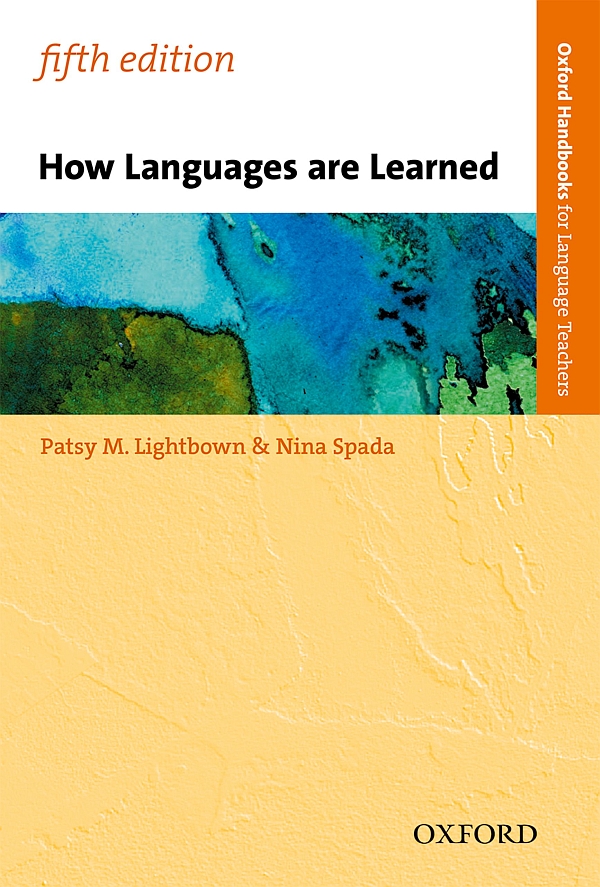
How Languages are Learned
Fifth edition
Published in this series
Oxford Handbooks for Language Teachers
Teaching American English Pronunciation
Peter Avery and Susan Ehrlich
Putting CLIL into Practice
Phil Ball, Keith Kelly, and John Clegg
Doing Second Language Research
James Dean Brown and Theodore S. Rodgers
Designing and Analyzing Language Tests
Nathan T. Carr
ESOL: A Critical Guide
Melanie Cooke and James Simpson
Supporting Learners with Dyslexia in the ELT Classroom
Michele Daloiso
Success in English Teaching
Paul Davies and Eric Pearse
English for Academic Purposes
Edward de Chazal
From Experience to Knowledge
Julian Edge and Sue Garton
Teaching Business English
Mark Ellis and Christine Johnson
Intercultural Business Communication
Robert Gibson
Teaching and Learning in the Language Classroom
Tricia Hedge
Teaching Second Language Reading
Thom Hudson
Teaching English Overseas: An Introduction
Sandra Lee McKay
Teaching English as an International Language
Sandra Lee McKay
How Languages are Learned (5th Edition)
Patsy M. Lightbown and Nina Spada
Communication in the Language Classroom
Tony Lynch
Teaching Second Language Listening
Tony Lynch
Teacher Wellbeing
Sarah Mercer and Tammy Gregersen
Teaching Young Language Learners (2nd Edition)
Annamaria Pinter
The Oxford ESOL Handbook
Philida Schellekens
Exploring Learner Language
Elaine Tarone and Bonnie Swierzbin
Technology Enhanced Language Learning
Aisha Walker and Goodith White
Teaching the Pronunciation of English as a Lingua Franca
Robin Walker
How Vocabulary is Learned
Stuart Webb and Paul Nation
Exploring Psychology in Language Learning and Teaching
Marion Williams, Sarah Mercer, and Stephen Ryan
Doing Task-based Teaching
Jane Willis and Dave Willis
Explaining English Grammar
George Yule
How Languages are Learned
Fifth edition
Patsy M. Lightbown & Nina Spada
Great Clarendon Street, Oxford, OX2 6DP, United Kingdom
Oxford University Press is a department of the University of Oxford. It furthers the Universitys objective of excellence in research, scholarship, and education by publishing worldwide. Oxford is a registered trade mark of Oxford University Press in the UK and in certain other countries
Oxford University Press 2021
The moral rights of the author have been asserted
eBook Edition
ISBN: 978 0 19 440630 7 eBook (epub)
First published in 2021
No copying or file sharing
This digital publication is protected by international copyright laws. No part of this digital publication may be reproduced, modified, adapted, stored in a retrieval system, or transmitted, in any form or by any means, to any other person or company without the prior permission in writing of Oxford University Press, or as expressly permitted by law. Enquiries concerning reproduction outside the scope of the above should be sent to the ELT Rights Department, Oxford University Press, at the address above
You must not modify, adapt, copy, store, transfer or circulate the contents of this publication under any other branding or as part of any other product. You may not print out material for any commercial purpose or resale
Any websites referred to in this publication are in the public domain and their addresses are provided by Oxford University Press for information only. Oxford University Press disclaims all and any responsibility for the content of such websites
ACKNOWLEDGEMENTS
The authors and publisher are grateful to those who have given permission to reproduce the following extracts and adaptations of copyright material : p.17 From Language Development and Language Disorders by Lois Bloom and Margaret Lahey, New York, Copyright 1978 by John Wiley & Sons, Inc., reprinted by permission via PLS Clear; p.49 Adapted from Table 2.1 Average order of acquisition of grammatical morphemes for English as a second language (children and adults), Krashen 1977, reprinted by permission of Stephen Krashen; p.55 Speeding up acquisition of his and her: Explicit L1/L2 contrasts help, White, J., p.197 in Second Language Acquisition and the Younger Learner: Childs play? (2008), published by John Benjamins Publishing Company, Amsterdam/Philadelphia, https://benjamins.com/catalog/lllt.23, reprinted by permission; p.56 Adapted from Catherine Doughty, Second language instruction does make a difference: Evidence from an Empirical Study of SL Relativization in Studies in Second Language Acquisition, 13 (4), 431469, reproduced by permission of Cambridge University Press; p.150152 From Corrective Feedback and Learner uptake: Negotiation of Form in Communicative Classrooms by Lyster, R. & Ranta, L. (1997) in Studies in Second Language Acquisition, 19 (1), p.3761, reprinted by permission of Cambridge University Press; p.147148 From Talking it through: two French immersion learners response to reformulation by Swain, M. & Lapkin, S. (2002), in International Journal of Educational Research, 37 (34), 285304, Copyright 2002, reprinted by permission of Elsevier.
Illustrations by : Rupert van Wyk (working in the style of Sophie Grillet)/Beehive Illustration Agency
To the teachers and students from whom we have learned so much
CONTENTS
ACKNOWLEDGEMENTS
We wish first to thank the readers who have responded so positively to the four previous editions of this book. It is their enthusiastic response that has brought us to this fifth edition. We are grateful to readers who have sent us notes or approached us in seminars or at conferences to suggest new topics or sources and sometimes to point out places where we have made errors, or where we could have made our points more clearly. We cannot reconstruct a complete list of these informal contributions, but we hope those readers will recognize our efforts to respond to their concerns. We take full responsibility for remaining errors and limitations.
With each edition, we have benefited from suggestions and feedback offered by colleagues and students. Our thanks to Ahlem Ammar, Alexander Ary, Philippa Bell, Luz Celaya, Laura Collins, Maria Frhlich, Randall Halter, Zhaohong Han, Marlise Horst, Jim Hu, Phillip Hubbard, Youjin Kim, Roy Lyster, Alison Mackey, Kim McDonough, Shawn Loewen, Paul Meara, Imma Miralpeix, Vicki Murphy, Carmen Muoz, Heike Neumann, Howard Nicholas, Paul Quinn, Katherine Rehner, Mela Sarkar, Raquel Serrano, Younghee Sheen, Wataru Suzuki, and Yasuyo Tomita. Leila Ranta and Jude Rand made essential contributions to the first edition.
At Oxford University Press, we owe a debt to Henry Widdowson for his early encouragement and to Cristina Whitecross, who was our editor for the first three editions. Ann Hunter was a tireless editor for the fourth edition. We are grateful to Sophie Falcon-Lang, Yordanka Kavalova, and Antoinette Meehan, who have worked with us through the development of this new edition. Special thanks go to Julia Bell who oversaw the content editing of this new edition.
PREFACE TO THE FIFTH EDITION
How Languages Are Learned started out as a series of professional development workshops for teachers in Quebec, Canada, where we both worked for many years. Four editions of the book have now travelled far from those origins. When we were working on the first edition in the 1980s and 1990s, we were still in the early days of remarkable growth of research in second language acquisition. For each new edition, the decisions about what to include have grown more difficult because research in the field has grown dramatically. Keeping the book to a reasonable length has often meant choosing between classics in the field and important new studies. As in the fourth edition, we have annotated some Suggestions for further reading at the end of each chapter and we encourage readers to follow these publications and the reference list to deepen their understanding of topics that we can only introduce here.
Font size:
Interval:
Bookmark:
Similar books «How Languages Are Learned 5th Edition»
Look at similar books to How Languages Are Learned 5th Edition. We have selected literature similar in name and meaning in the hope of providing readers with more options to find new, interesting, not yet read works.
Discussion, reviews of the book How Languages Are Learned 5th Edition and just readers' own opinions. Leave your comments, write what you think about the work, its meaning or the main characters. Specify what exactly you liked and what you didn't like, and why you think so.


